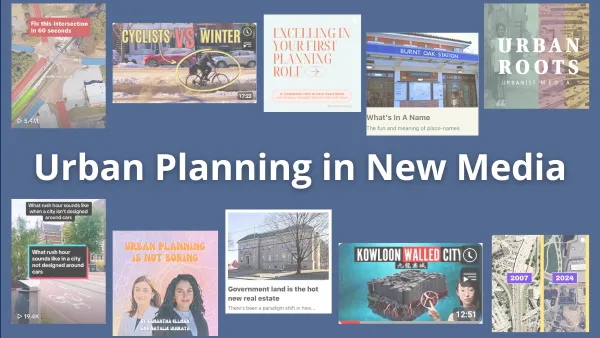Constantly updated, the internet has created an important tool for accessing up-to date information—text, still images, and video. Increasingly it also provides a window into aspects of history, including planning history, that have previously been difficult to find. Documents, indexes to archival materials, and the photographic and map collections of historical societies are accessible online. Less well known are film and video resources—resources that can be played online or downloaded. The Library of Congress, Motion Picture, Broadcasting and Recorded Sound Division now boasts an outstanding collection of hundreds of videos relevant to urban issues. Some examples illustrate the range:
Constantly updated, the internet has created an important tool for accessing up-to date information-text, still images, and video. Increasingly it also provides a window into aspects of history, including planning history, that have previously been difficult to find. Documents, indexes to archival materials, and the photographic and map collections of historical societies are accessible online. Less well known are film and video resources-resources that can be played online or downloaded. The Library of Congress, Motion Picture, Broadcasting and Recorded Sound Division now boasts an outstanding collection of hundreds of videos relevant to urban issues.
Some examples illustrate the range:
• A clip from 1899, 104th Street Curve, New York, Elevated Railway also shows nearby buildings and streets. It is one of a number featuring life in turn of the century New York.
• The City (1939), from the American Institute of Planners, with commentary by Lewis Mumford, is part of the large Prelinger Collection that includes many documentaries: http://www.archive.org/details/prelinger. The collection's wonderful tag cloud represents the universe of collection topics including city planning, urban renewal, transportation, and racism: http://www.archive.org/browse.php?field=/metadata/subject&collection=pr….
• Many of the films in the Prelinger collection were produced by industrial associations or in order to advocate a policy. In Community Growth: Crisis and Challenge (1959) the National Association of Home Builders criticizes sprawl and promotes better planning. A Place to Live (1948), a documentary-style drama, vividly illustrates Philadelphia before urban renewal. In We Work Again (1930s), the U.S. government advertises the success of the Work Projects Administration in employing African Americans.
Of course there is more to these collections than planning. Their open source movies range from an animated movies to what is described as, and is, "extremely graphic" archival military footage of Nazi Concentration Camps. (See http://www.archive.org/details/opensource_movies for examples.)
Overall, for planners these collections are rich resources and important windows into the history of cities and regions. Many are are obviously dated--The City features happy mothers doing laundry together with a voice over about the joys of gossip. However, they provide an important resource for helping make planning history more accessible.
Ann Forsyth has recently experimented with putting an educational video online as a downloadable file and a video available via YouTube-the 11-minute Corridor Housing Initiative: Because Place Matters. She was also the principal investigator in a project creating a free image bank of over 30,000 still images related to urban planning and design. Note, it may take a little time to set up one's computer to play the various formats-but persevere.

National Parks Layoffs Will Cause Communities to Lose Billions
Thousands of essential park workers were laid off this week, just before the busy spring break season.

Retro-silient?: America’s First “Eco-burb,” The Woodlands Turns 50
A master-planned community north of Houston offers lessons on green infrastructure and resilient design, but falls short of its founder’s lofty affordability and walkability goals.

Delivering for America Plan Will Downgrade Mail Service in at Least 49.5 Percent of Zip Codes
Republican and Democrat lawmakers criticize the plan for its disproportionate negative impact on rural communities.

Test News Post 1
This is a summary

Test News Headline 46
Test for the image on the front page.

Balancing Bombs and Butterflies: How the National Guard Protects a Rare Species
The National Guard at Fort Indiantown Gap uses GIS technology and land management strategies to balance military training with conservation efforts, ensuring the survival of the rare eastern regal fritillary butterfly.
Urban Design for Planners 1: Software Tools
This six-course series explores essential urban design concepts using open source software and equips planners with the tools they need to participate fully in the urban design process.
Planning for Universal Design
Learn the tools for implementing Universal Design in planning regulations.
EMC Planning Group, Inc.
Planetizen
Planetizen
Mpact (formerly Rail~Volution)
Great Falls Development Authority, Inc.
HUDs Office of Policy Development and Research
NYU Wagner Graduate School of Public Service






























